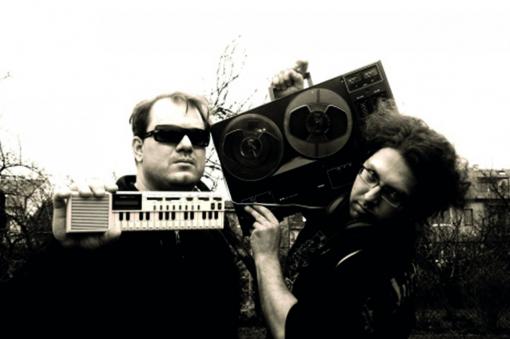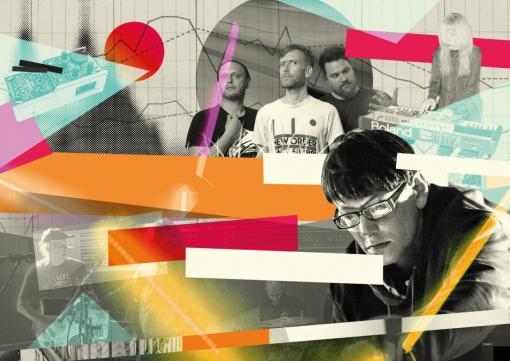Electronic music, big beat and clubbing go together - but that’s only a small part of the truth. In fact electronic music was here long before clubbing, and thanks to enlightened teachers at JAMU it was doing very well indeed in Brno as early as the 1960s. That is, long before synthesizers and sequencers appeared on rock podiums, long before any old band had a computer, long before the first dance parties in glittering halls and dark cellars. Today electronic music is one of music’s most omnipresent genres: neither dance parties nor contemporary operas can do without it. Electronic big beat music has occupied reggae and swing, remixing is a daily affair, Brno artists have learned to sell instruments they built themselves to the whole world and to amplify an old knitting machine. As early as 1907 the composer Ferruccio Busoni dreamt of the future potential of electronic music, but not even his imagination and genius could have anticipated what Thaddeus Cahill’s first weird experiment with an immense electrical organ would lead to one day.
Electronic Music all around
Since its beginnings in Brno, electronic music has flowed though the city’s musical life in several currents that at various moments meet up, join forces for a while and then part ways. This still remains true, but at the same time there are growing numbers of artists for whom electronic music is a means of expression no different from a guitar and who turn to it when needed.
The Brno composer, producer and sound designer Tomáš Vtípil plays the violin and can be heard in the streets with the acoustic band Urband, but his electronic projects are more ambitious and more audible. He says of himself that he produces a racket, clearly evident in his solo projects using electronic means to attack underground roots. Vtípil’s spatial compositions for electronic music and choir have been performed at the Exposition of New Music festival, and everything that pertains to electronic music today appears in his work, with the possible exception of purely dance creations.
 Bullerbyne band members Luboš Mikula and Boleslav Březovský. Photo: band archives
Bullerbyne band members Luboš Mikula and Boleslav Březovský. Photo: band archives
First Compositions, then Big Beat Electronic Music
The first conceptual use of electronic music was in the work of Miloslav Ištvan and Alois Piňos. Their projects, strongly grounded intellectually and thoughtfully constructed, were far from what most people imagine by the term electronic music today. But their work back then was “basic research” that their students could later draw on and that musical genres oriented more to entertainment could be based on. Piňos and Ištvan also benefitted from the Electroacoustic Music Studio established in the midsixties by Brno Radio. This stimulated the use of electronic music in serious musical art – rock and alternative had to wait some time for their first major electronic achievements.
But it’s hard not to see the connection between electroacoustic compositions that came in the wake of abstract films that Piňos and the artist Dalibor Chatrný created together and the later concerts of Progres 2, which made use of visual media techniques. But Progres 2 was still marked by too little electronic music and too much live playing even though the composer Karel Horký, better known under the name Daniel Forró, deserted Progres for electronic music.
Electronic Music behind the Iron Curtain
Alternative bands only began creating electronic music projects in the eighties; among the first were Něco, co hýbe ušima and Frontální porucha. However, it was difficult then to obtain suitable electronic music instruments: they could only be purchased, at great expense, on the other side of the Iron Curtain and often had to be smuggled across the border.
This was the case with Ser un Peyjalero, which imported a Roland D-50 synthesizer from the West at the end of the 1980s. Peyjalero realized that even alternative music needs good instruments if it wants to sound good. Even in this large band, which had a brass section, the synthesizer added a striking element to its sound. When its leader, Jiři Pejchal, founded a new band, Mare Nigrum, in 1995, he moved to fullblooded electronic music unlike the hermetically existential Peyjalero, here there was even big beat dance music.
From Cellars to Disco Halls
Songs on records were replaced by acid house, dub, breakbeat, techno and a host of other styles almost impossible for the uninitiated to distinguish from one another. A certain mutual animosity prevailed among their fans – though everyone hated commercial house music, which started to show up even on private radio stations.
In Brno people began flocking to Mescalito, where the music was played from records by DJ Boris, one of the owners, famous for a memorable set he played from the pulpit of the city’s Red Church. Discotheques flourished big time in the attractive new Bobycentrum. Following the latest trend, they began to play from vinyls in the Fan Favorit club, in the originally under- ground-punk oriented Šedá litina, in its successor the TetraHydroClub and in the rock music Mersey Club. The first portable sound system collectives also appeared, the best known being Vosa, which today also functions as a small brewery.
At the other end of the scale, around the beginning of the new millennium Supersonic Garage and Orion Hall began organizing huge dance parties attended by thousands. Brno also saw the emergence of rave.cz, a server dedicated to electronic and dance music.
 Open air concert of electronic music at Špilberk Castle
Open air concert of electronic music at Špilberk Castle
Synthesizers as Nostalgia-free Retro
Nor has Brno been immune from the electronic music retro wave. The big winner here has been the electro-pop band Midi Lidi, which began in 2006 and three years later was awarded a prize for music for the film Protector. The more thoughtful and ethereal face of contemporary electronic music is represented by Fiordmoss, a band formed by students at the Brno University of Technology’s Faculty of Fine Arts. Bastl Instruments produces outstanding DIY modular synthesizers: their instruments can be found in the homes of Depeche Mode’s Martin Gore and Trent Reznor of Nine Inch Nails.
Vašulka Kitchen Brno: A Multimedia Kitchen from New York
Multimedia projects have always gone hand-in-hand with electronic and electroacoustic music and other related musical genres and subgenres. One of the founders of electronic audiovisual art and video art is the Brno native Woody Vašulka (born 1937). Since 2016 a Brno NGO named Vašulka Kitchen Brno has been promoting his work.
Vašulka and his wife Steina founded the first Kitchen in 1971 in New York. The name came naturally: it was actually situated in a kitchen, the only space available at the time. Vašulka Kitchen Brno is located in the city’s House of Arts: clearly Vašulka’s ideas are taken more seriously now than was the case a half century ago. Vašulka Kitchen Brno was founded by Tomáš Ruller, Jennifer Helia De Felice and Viktor Pantůček. All three are active in the field of contemporary art, both theoretically and in practice, as teachers, performers, musicians, scholars and dramaturges. The association focuses on the lifework of the Vašulkas and equally intensively on offering all manner of support for artists making use of new technologies.
Multimedia art and electronic music made their appearance in Brno as early as the 1960s, so the Vašulka Kitchen joins a long tradition. It draws on people who have worked hard to ensure that the tradition remained alive and continued to develop.
The curator Barbora Šedivá is one of the cofounders of 4AM/Forum for Architecture and Media, which has always promoted multimedia, even offering courses in electronic music for kids. Other members of Vašulka Kitchen Brno include Ondřej Merta of Bastl Instruments, and Ivan Palacký, codesigner of the association’s premises, an accomplished player on an electronically amplified knitting machine and the initiator of and participant in many music projects. Contemporary galleries have long since expanded their remit beyond paintings, graphic works and statues to include electronic music, sounds and other nontangible media. Vašulka Kitchen Brno functions as an archive and catalyst of art for the future but also as a practical demonstration of the multifaceted interconnection of artists and the contemporary world.
































No comment added yet..